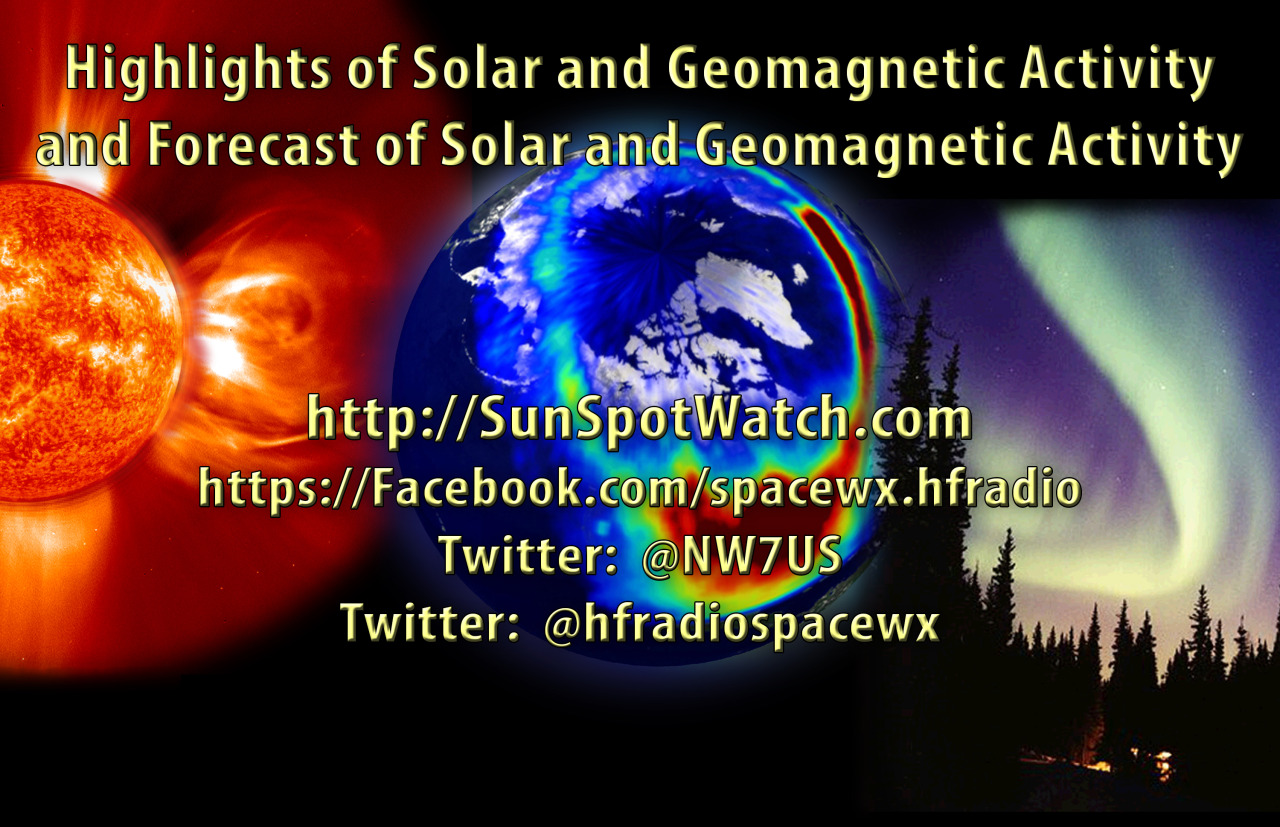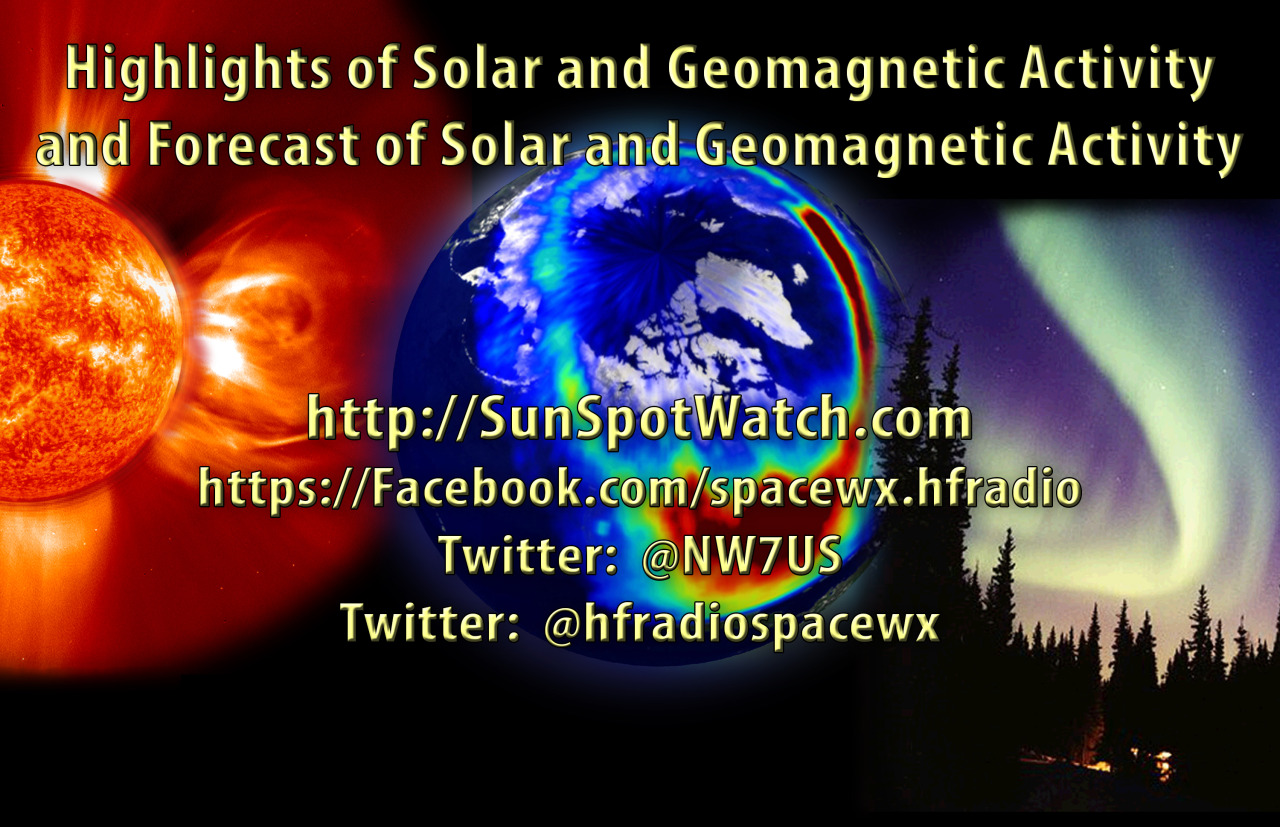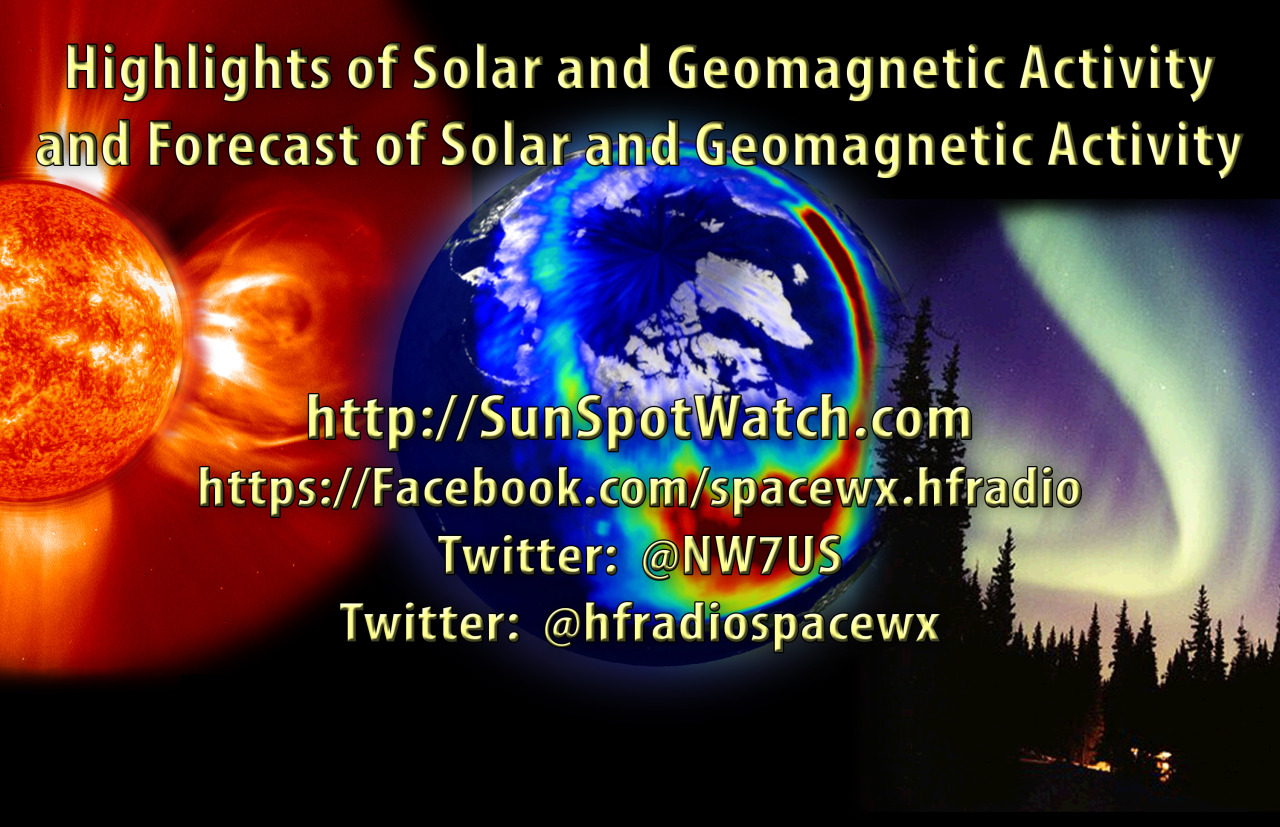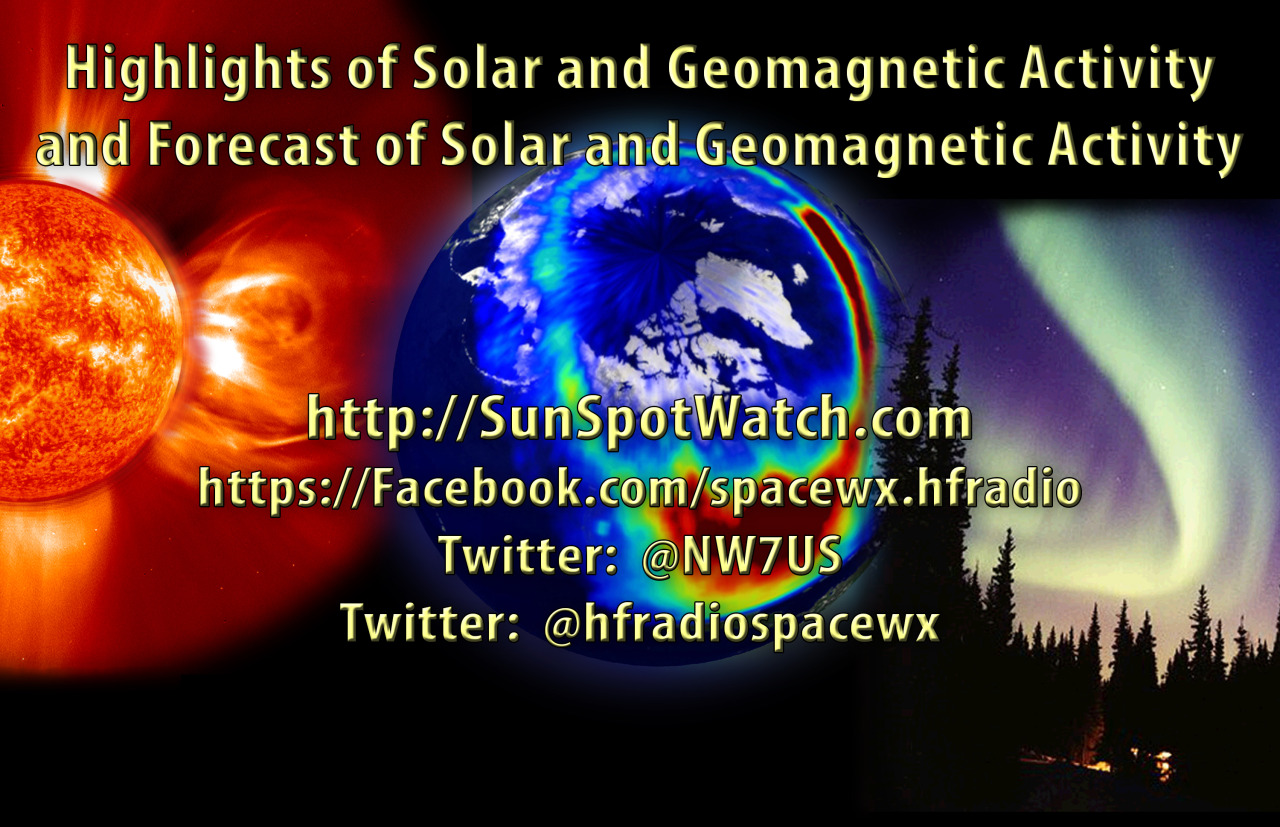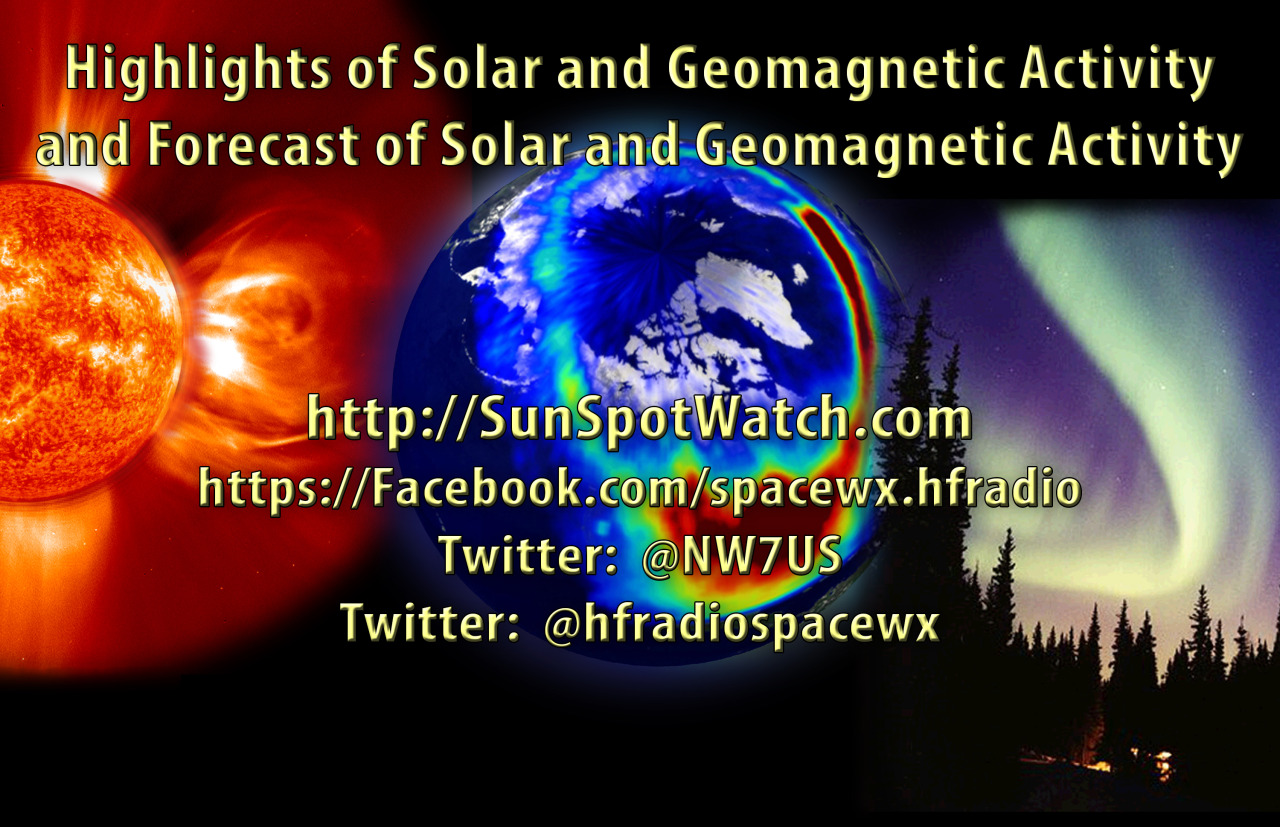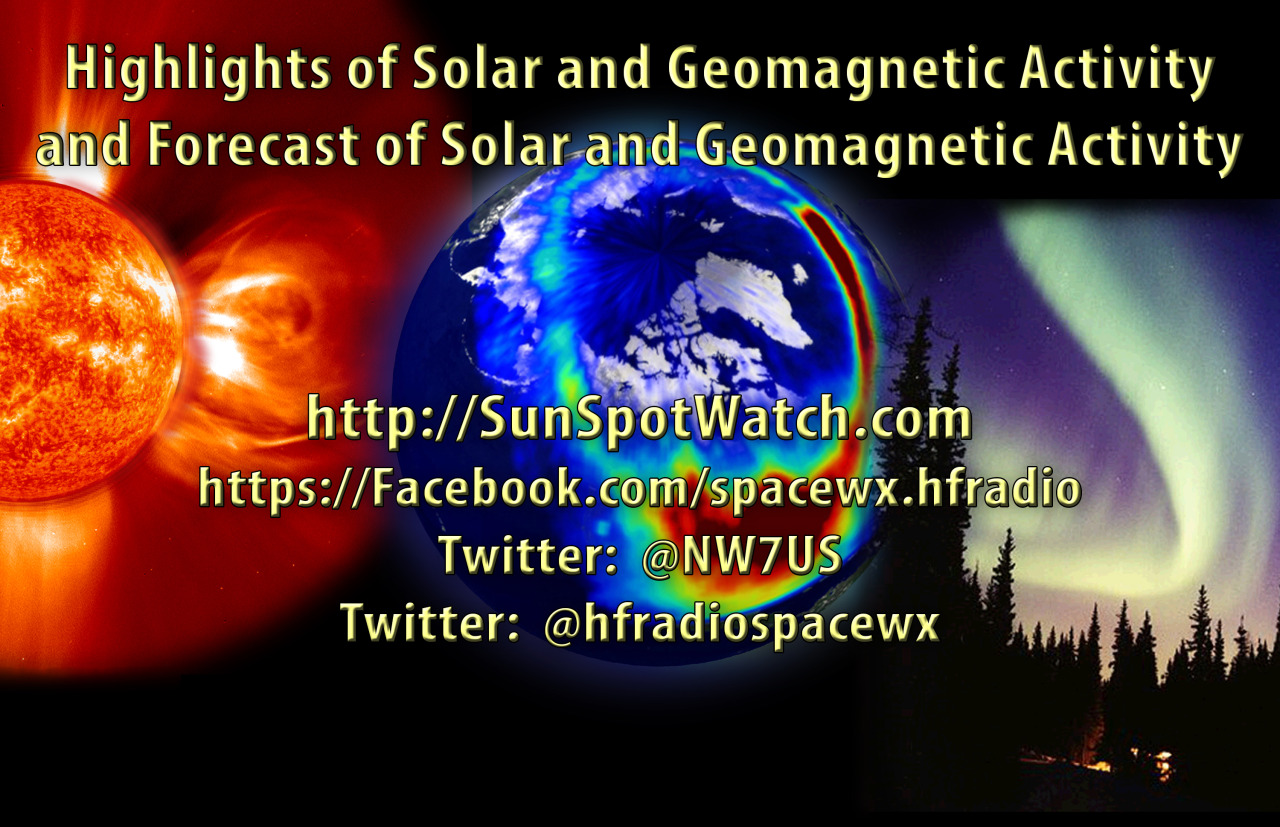Author Archive
 Weekly Propagation Summary – 2016 Mar 14 16:10 UTC
Weekly Propagation Summary – 2016 Mar 14 16:10 UTC
Here is this week’s space weather and geophysical report, issued 2016 Mar 14 0430 UTC.
Highlights of Solar and Geomagnetic Activity 07 – 13 March 2016
Solar activity reached low levels on 08-09 and 12 March. The largest event of the period was a C3 flare from Region 2519 (N05, L=007, class/area=Cso/80 on 13 Mar) at 09/1250 UTC. Very low levels of solar activity were observed throughout the remainder of the period. No coronal mass ejections (CMEs) observed in coronagraph imagery were determined to be Earth-directed.
No proton events were observed at geosynchronous orbit.
The greater than 2 MeV electron flux at geosynchronous orbit was at high levels on 07-11 Mar and decreased to moderate levels on 12-13 Mar.
Geomagnetic field activity reached G1 (Minor) geomagnetic storm levels early on 07 Mar due to the influence of a positive polarity coronal hole high speed stream (CH HSS). Activity levels subsided to quiet to unsettled levels on 08 Mar and quiet levels by 09 Mar. Quiet to unsettled conditions were observed on 10 Mar and continued into early on 11 Mar when the co-rotating interaction region (CIR) ahead of a positive polarity CH HSS caused G2 (Moderate) geomagnetic storm conditions. As the CH HSS progressed, conditions tapered down to active levels early on 12 Mar and into quiet to unsettled for the remainder of the day. Activity continued to subside with only quiet conditions observed on 13 Mar.
Forecast of Solar and Geomagnetic Activity 14 March – 09 April 2016
Solar activity is expected to be at very low levels with a chance for C-class flares throughout the forecast period.
No proton events are expected at geosynchronous orbit.
The greater than 2 MeV electron flux at geosynchronous orbit is expected to be at high levels on 16-21 Mar and 04-06 Apr. Moderate levels are expected on 22 Mar-03 Apr and 07-09 Apr. Normal levels are expected on 14-15 Mar.
Geomagnetic field activity is expected to reach G1 (Minor) storm levels on 15-16 Mar and 02-03 Apr due to the influence of a negative polarity CH HSS. Active conditions are expected on 17 Mar and 08 Apr. Unsettled conditions are expected 18 Mar and 01, 04, 07, 08 Apr. Quiet conditions are expected throughout the remainder of the outlook period under a nominal solar wind regime.
Don’t forget to visit our live space weather and radio propagation web site, at: http://SunSpotWatch.com/
Live Aurora mapping is at http://aurora.sunspotwatch.com/
If you are on Twitter, please follow these two users: + https://Twitter.com/NW7US + https://Twitter.com/hfradiospacewx
Get the space weather and radio propagation self-study course, today. Visit http://nw7us.us/swc for the latest sale and for more information!
Check out the stunning view of our Sun in action, as seen during the last five years with the Solar Dynamics Observatory (SDO): https://www.youtube.com/watch?v=zXN-MdoGM9g
We’re on Facebook: http://NW7US.us/swhfr
 Weekly Propagation Summary – 2016 Mar 07 16:10 UTC
Weekly Propagation Summary – 2016 Mar 07 16:10 UTC
Here is this week’s space weather and geophysical report, issued 2016 Mar 07 0539 UTC.
Highlights of Solar and Geomagnetic Activity 29 February – 06 March 2016
Solar activity reached low levels on 04 March due to a C1 flare from Region 2506 (S06, L=223, class/area=Dai/130 on 29 Feb) at 0900 UTC. Very low levels were observed for the remainder of the period. No Earth-directed coronal mass ejections (CMEs) were observed in coronagraph imagery.
No proton events were observed at geosynchronous orbit.
The greater than 2 MeV electron flux at geosynchronous orbit reached moderate levels throughout the period.
Geomagnetic field activity was at quiet or quiet to unsettled levels until 06 March, when a negative polarity coronal hole high-speed stream (CH HSS) became geoeffective. During the onset of the co-rotating interaction region (CIR) total field (Bt) to a maximum of 22 nT at 06/1646 UTC while the Bz component reached a maximum southward deflection of -18 nT at 06/1834 UTC. Solar wind speeds increased to a peak of around 580 km/s at the end of the period. The geomagnetic field reached G1 (Minor) during the 1500-1800 synoptic period, G2 (Moderate) during the 1800-2100 synoptic period, and G3 (Strong) Geomagnetic Storm levels during the 2100-2400 UTC synoptic period.
Forecast of Solar and Geomagnetic Activity 07 March – 02 April 2016
Solar activity is expected to be at very low levels, with a chance for C-class flares, throughout the forecast period.
No proton events are expected at geosynchronous orbit.
The greater than 2 MeV electron flux at geosynchronous orbit is expected to be at high levels from 07-10 March and 17-22 March due to CH HSS effects. Moderate levels are expected from 11-16 March and 23 March – 02 April.
Geomagnetic field activity is likely to reach G1 (Minor) geomagnetic storm levels on 07 March, 17-19 March, and 02 Apr in reponse to effects from multiple coronal holes. Quiet to quiet to unsettled conditions are anticipated for rest of the forecast period under nominal solar wind conditions.
Don’t forget to visit our live space weather and radio propagation web site, at: http://SunSpotWatch.com/
Live Aurora mapping is at http://aurora.sunspotwatch.com/
If you are on Twitter, please follow these two users: + https://Twitter.com/NW7US + https://Twitter.com/hfradiospacewx
Get the space weather and radio propagation self-study course, today. Visit http://nw7us.us/swc for the latest sale and for more information!
Check out the stunning view of our Sun in action, as seen during the last five years with the Solar Dynamics Observatory (SDO): https://www.youtube.com/watch?v=zXN-MdoGM9g
We’re on Facebook: http://NW7US.us/swhfr
 How-To: Send Perfect Morse Code by Hand (Vintage Video)
How-To: Send Perfect Morse Code by Hand (Vintage Video)
What is the proper (and most efficient) technique for creating Morse code by hand, using a manual Morse code key? Ham radio operators find Morse code (and the ‘CW’ mode, or ‘Continuous Wave’ keying mode) very useful, even though Morse code is no longer required as part of the licensing process. Morse code is highly effective in weak-signal radio work. And, preppers love Morse code because it is the most efficient way to communicate when there is a major disaster that could wipe out the communications infrastructure.
While this military film is antique, the vintage information is timeless, as the material is applicable to Morse code, even today.
More about Morse code, at my website: http://cw.hfradio.org
Thank you for watching, commenting, and most of all, for subscribing. By subscribing, you will be kept in the loop for new videos and more… my YouTube Channel: https://YouTube.com/NW7US
See my Video Playlist for related Morse code vidoes:
 Weekly Propagation Summary – 2016 Feb 29 16:10 UTC
Weekly Propagation Summary – 2016 Feb 29 16:10 UTC
Here is this week’s space weather and geophysical report, issued 2016 Feb 29 0233 UTC.
Highlights of Solar and Geomagnetic Activity 22 – 28 February 2016
Solar activity reached low levels with only C-class flare activity observed this period. Region 2506 (S05, L=224, class/area=110/Dai o 28 Feb) was responsible for nearly all flare activity this period including three low-level C-class flares, the largest of which was a C3/Sf flare at 0500 UTC on 27 Feb. A filament eruption centered near S16E19 (vicinity of Region 2506) was observed in SDO/AIA imagery between 0030-0130 UTC on 18 Feb but no associated coronal mass ejection (CME) was observed in LASCO coronagraph imagery suggesting the bulk of the plasma was reabsorbed. No Earth-directed CMEs were observed this period.
No proton events were observed at geosynchronous orbit.
The greater than 2 MeV electron flux at geosynchronous orbit reached high levels on 22-24 and 28 Feb with moderate levels observed throughout the remainder of the period.
Geomagnetic field activity briefly reached unsettled levels on 23-24 and 26 Feb with quiet conditions observed throughout the remainder of the period under a nominal solar wind regime.
Forecast of Solar and Geomagnetic Activity 29 February – 26 March 2016
Solar activity is expected to be very low with a chance for C-class flares on 29 Feb and 15-26 Mar. Solar activity is expected to increase to low levels with a chance for M-class flares (R1-R2 (Minor-Moderate) Radio Blackouts) on 01-14 Mar due to the return of old Region 2497 (N12, L=240) which produced four M-class flares last rotation.
No proton events are expected at geosynchronous orbit barring any significant flare activity.
The greater than 2 MeV electron flux at geosynchronous orbit is expected to reach high levels on 15-22 Mar, moderate levels on 04-05, 07-08, 13-14, and 23-26 Mar, and at normal levels for the remainder of the period.
Geomagnetic field activity is expected to reach G1 (Minor) geomagnetic storm levels on 14-16 Mar and active levels on 01, 06, and 17 Mar due to the effects of multiple recurrent coronal hole high speed streams (CH HSSs). Quiet or quiet to unsettled geomagnetic field conditions under a nominal solar wind regime are expected for the remainder of the period.
Don’t forget to visit our live space weather and radio propagation web site, at: http://SunSpotWatch.com/
Live Aurora mapping is at http://aurora.sunspotwatch.com/
If you are on Twitter, please follow these two users: + https://Twitter.com/NW7US + https://Twitter.com/hfradiospacewx
Get the space weather and radio propagation self-study course, today. Visit http://nw7us.us/swc for the latest sale and for more information!
Check out the stunning view of our Sun in action, as seen during the last five years with the Solar Dynamics Observatory (SDO): https://www.youtube.com/watch?v=zXN-MdoGM9g
We’re on Facebook: http://NW7US.us/swhfr
 Weekly Propagation Summary – 2016 Feb 22 16:10 UTC
Weekly Propagation Summary – 2016 Feb 22 16:10 UTC
Here is this week’s space weather and geophysical report, issued 2016 Feb 22 0359 UTC.
Highlights of Solar and Geomagnetic Activity 15 – 21 February 2016
Solar activity reached moderate levels early in the period due to an M1/1n flare (R1-minor radio blackout) from Region 2497 at 1056 UTC on 15 Feb, but low levels of activity were observed on 16-19 Feb with very low levels observed on 20-21 Feb as Region 2497 rotated behind the west limb. Region 2497 (N13, L=087, class/area=Eac/250 on 12 Feb) was the largest, most magnetically complex and active sunspot region on the disk this period, however, despite the frequency of solar activity this period no Earth-directed coronal mass ejections (CMEs) were observed.
No proton events were observed at geosynchronous orbit.
The greater than 2 MeV electron flux at geosynchronous orbit reached moderate levels on 15-16 Feb but an enhanced solar wind environment due to a coronal hole high speed stream (CH HSS) caused an increase to high flux levels throughout the remainder of the period (17-21 Feb), with a peak value of 36,500 pfu observed at 1755 UTC on 19 Feb.
Geomagnetic field activity reached G2 (Moderate) geomagnetic storm levels this period. The onset of a south polar-connected negative polarity CH HSS caused and isolated period of active conditions late on 15 Feb, unsettled to G2 (Moderate) geomagnetic storms on 16-17 Feb, and unsettled to G1 (Minor) geomagnetic storms on 18 Feb. As the CH HSS rotated out of geoeffective position, geomagnetic field activity decreased from quiet to unsettled levels on 19-20 Feb to quiet levels on 21 Feb due to the return of a nominal solar wind regime.
Forecast of Solar and Geomagnetic Activity 22 February – 19 March 2016
Solar activity is likely to be at low levels with a slight chance for M-class flares (R1-R2 (Minor-Moderate) Radio Blackouts) on 22-29 Feb and 15-19 Mar. C-class flares are expected on 01-14 Mar with a chance for M-class flares due to the anticipated return of Region 2497 (N12, L=087) which produced four M-class flares last rotation.
No proton events are expected at geosynchronous orbit, barring any significant flare activity.
The greater than 2 MeV electron flux at geosynchronous orbit is expected to reach high levels on 22 Feb and 15-19 Mar due to an enhanced solar wind environment caused by coronal hole high speed streams (CH HSSs). Moderate levels are likely on 23-24 Feb, 04-05, 07-08 and 13-14 Mar with low flux levels expected for the remainder of the period.
Geomagnetic field activity is likely to reach G1 (Minor) geomagnetic storm levels on 14-16 Mar and active field conditions are likely on 01, 03, 06 and 17 Mar, all due to the effects of multiple CH HSSs. The remainder of the period is expected to be at quiet or quiet to unsettled levels under a nominal solar wind regime.
Don’t forget to visit our live space weather and radio propagation web site, at: http://SunSpotWatch.com/
Live Aurora mapping is at http://aurora.sunspotwatch.com/
If you are on Twitter, please follow these two users: + https://Twitter.com/NW7US + https://Twitter.com/hfradiospacewx
Get the space weather and radio propagation self-study course, today. Visit http://nw7us.us/swc for the latest sale and for more information!
Check out the stunning view of our Sun in action, as seen during the last five years with the Solar Dynamics Observatory (SDO): https://www.youtube.com/watch?v=zXN-MdoGM9g
We’re on Facebook: http://NW7US.us/swhfr
 Weekly Propagation Summary – 2016 Feb 15 16:10 UTC
Weekly Propagation Summary – 2016 Feb 15 16:10 UTC
Here is this week’s space weather and geophysical report, issued 2016 Feb 15 0238 UTC.
Highlights of Solar and Geomagnetic Activity 08 – 14 February 2016
Solar activity was low from 08-11 Feb. The largest C-class event during that period was a C8/1f observed at 11/2103 UTC from Region 2497 (N13, L=087, class/area Eac/250 on 12 Feb) with associated Type II (est. speed 483 km/s) and Type IV radio sweeps. A CME was visible following this event and is anticipated to arrive at Earth early on 15 Feb. Solar activity was moderate from 12-14 Feb with Region 2497 producing an M1 flare each day. No other Earth-directed CMEs were observed.
No proton events were observed at geosynchronous orbit.
The greater than 2 MeV electron flux at geosynchronous orbit was at normal to moderate levels during the period.
Geomagnetic field activity began the week at minor storm levels due to effects from a co-rotating interaction region (CIR) ahead of a CH HSS. Predominately quiet to unsettled levels were observed for the remainder of the period with isolated active periods on 09, 11 and 12 Feb associated with extended periods of negative Bz.
Forecast of Solar and Geomagnetic Activity 15 February – 12 March 2016
Solar activity is expected to be at very low to low levels with a chance for M-class flares from 15-17 Feb. Activity is expected to decrease to very low levels with only a chance for C-class flares from 18-29 Feb as Region 2497 moves beyond the west limb. Low levels are anticipated once again on 01-12 Mar as well as a chance for M-class flares with the return of Region 2497.
A slight chance for a proton event exists at geosynchronous orbit from 15-17 Feb due to the flare potential and position of Region 2497.
The greater than 2 MeV electron flux at geosynchronous orbit is expected to be at normal to moderate levels for the majority of the period. High levels are likely on 18-20 Feb following effects from a CME and a subsequent CH HSS.
Geomagnetic field activity is expected to reach minor storm levels on 15 Feb due to effects from the 11 Feb CME. Quiet to active conditions are expected on 16 Feb as CME effects subside. Minor storm conditions are likely again on 17 Feb as a recurrent negative polarity CH HSS becomes geoeffective. Quiet to unsettled conditions are expected with isolated active periods possible on 18-20 Feb as CH HSS effects continue. Mostly quiet conditions are expected on 21-29 Feb. Quiet to unsettled conditions are expected from 01-03 Mar due to effects from a positive polarity CH HSS. Mostly quiet conditions are expected for the remainder of the period with unsettled to active periods possible on 06-07 Mar and 11 Mar as two sequential small recurrent coronal holes affect the field.
Don’t forget to visit our live space weather and radio propagation web site, at: http://SunSpotWatch.com/
Live Aurora mapping is at http://aurora.sunspotwatch.com/
If you are on Twitter, please follow these two users: + https://Twitter.com/NW7US + https://Twitter.com/hfradiospacewx
Get the space weather and radio propagation self-study course, today. Visit http://nw7us.us/swc for the latest sale and for more information!
Check out the stunning view of our Sun in action, as seen during the last five years with the Solar Dynamics Observatory (SDO): https://www.youtube.com/watch?v=zXN-MdoGM9g
We’re on Facebook: http://NW7US.us/swhfr
 Weekly Propagation Summary – 2016 Feb 08 16:10 UTC
Weekly Propagation Summary – 2016 Feb 08 16:10 UTC
Here is this week’s space weather and geophysical report, issued 2016 Feb 08 0222 UTC.
Highlights of Solar and Geomagnetic Activity 01 – 07 February 2016
Solar activity was at low levels throughout the entire period. Several regions produced low level C-class events, the largest a C5/Sf at 04/1822 UTC from Region 2494 (S11, L=162, class/area Dki/270 on 07 Feb). A filament eruption observed beginning on 05/1939 UTC near S19W28 was associated with a CME that is anticipated to be a glancing blow midday on 09 Feb. Several other small filament eruptions occurred but none were expected to be geoeffective.
No proton events were observed at geosynchronous orbit.
The greater than 2 MeV electron flux at geosynchronous orbit was at normal to moderate levels.
Geomagnetic field activity began the week at quiet to unsettled levels. Active to minor storm conditions were observed early on 03 Feb due to a co-rotating interactive region (CIR) followed by the onset of a positive polarity coronal hole high speed stream (CH HSS). Quiet to unsettled conditions were observed during largely nominal solar wind conditions from 04-07 Feb, with the exception of an isolated active period on 07 Feb due to prolonged negative Bz.
Forecast of Solar and Geomagnetic Activity 08 February – 05 March 2016
Solar activity is expected to be at low levels throughout the forecast period.
No proton events are expected at geosynchronous orbit.
The greater than 2 MeV electron flux at geosynchronous orbit is expected to be at normal to moderate levels with high levels possible from 12-16 Feb and 19-23 Feb following subsequent CH HSS events.
Geomagnetic field activity is expected to be at unsettled to active levels with isolated minor storm periods on 08 Feb due to prolonged negative Bz and negative polarity CH HSS effects. Quiet to active conditions are likely to continue into 09 Feb as effects continue along with a possible glancing blow from the 05 Feb CME. Quiet to unsettled conditions are expected from 10-12 Feb as a recurrent positive polarity HSS moves into a geoeffective position. Mostly quiet conditions are expected from 13-16 Feb. Quiet to unsettled conditions are expected from 17-19 Feb with active periods possible on 18 Feb due to effects from a recurrent negative polarity HSS. Predominately quiet conditions are expected from 20-29 Feb. Quiet to unsettled conditions are expected with isolated active periods possible on 01-03 Mar as another positive polarity CH HSS becomes geoeffective. Quiet conditions are expected to close out the forecast period.
Don’t forget to visit our live space weather and radio propagation web site, at: http://SunSpotWatch.com/
Live Aurora mapping is at http://aurora.sunspotwatch.com/
If you are on Twitter, please follow these two users: + https://Twitter.com/NW7US + https://Twitter.com/hfradiospacewx
Get the space weather and radio propagation self-study course, today. Visit http://nw7us.us/swc for the latest sale and for more information!
Check out the stunning view of our Sun in action, as seen during the last five years with the Solar Dynamics Observatory (SDO): https://www.youtube.com/watch?v=zXN-MdoGM9g
We’re on Facebook: http://NW7US.us/swhfr
